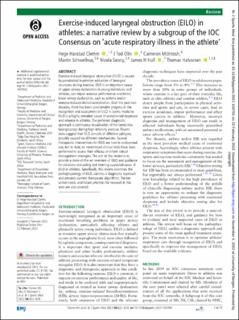| dc.contributor.author | Clemm, Hege Synnøve Havstad | |
| dc.contributor.author | McIntosh, Cameron | |
| dc.contributor.author | Schwellnus, Martin | |
| dc.contributor.author | Sewry, Nicola | |
| dc.contributor.author | Hull, James H. | |
| dc.contributor.author | Halvorsen, Thomas | |
| dc.contributor.author | Olin, James Tod | |
| dc.date.accessioned | 2023-03-02T13:05:58Z | |
| dc.date.available | 2023-03-02T13:05:58Z | |
| dc.date.created | 2022-08-29T15:36:36Z | |
| dc.date.issued | 2022 | |
| dc.identifier.citation | British Journal of Sports Medicine. 2022, 56(11), Side 622-629. | en_US |
| dc.identifier.issn | 0306-3674 | |
| dc.identifier.uri | https://hdl.handle.net/11250/3055409 | |
| dc.description | This is an open access article distributed in accordance with the Creative Commons Attribution Non Commercial (CC BY-NC 4.0) license, which permits others to distribute, remix, adapt, build upon this work non-commercially, and license their derivative works on different terms, provided the original work is properly cited, appropriate credit is given, any changes made indicated, and the use is non-commercial. | en_US |
| dc.description.abstract | Exercise-induced laryngeal obstruction (EILO) is caused by paradoxical inspiratory adduction of laryngeal structures during exercise. EILO is an important cause of upper airway dysfunction in young individuals and athletes, can impair exercise performance and mimic lower airway dysfunction, such as asthma and/or exercise-induced bronchoconstriction. Over the past two decades, there has been considerable progress in the recognition and assessment of EILO in sports medicine. EILO is a highly prevalent cause of unexplained dyspnoea and wheeze in athletes. The preferred diagnostic approach is continuous visualisation of the larynx (via laryngoscopy) during high-intensity exercise. Recent data suggest that EILO consists of different subtypes, possibly caused via different mechanisms. Several therapeutic interventions for EILO are now in widespread use, but to date, no randomised clinical trials have been performed to assess their efficacy or inform robust management strategies. The aim of this review is to provide a state-of-the-art overview of EILO and guidance for clinicians evaluating and treating suspected cases of EILO in athletes. Specifically, this review examines the pathophysiology of EILO, outlines a diagnostic approach and presents current therapeutic algorithms. The key unmet needs and future priorities for research in this area are also covered. | en_US |
| dc.language.iso | eng | en_US |
| dc.subject | asthma | en_US |
| dc.subject | athletes | en_US |
| dc.subject | exercise | en_US |
| dc.subject | respiratory system | en_US |
| dc.subject | sports medicine | en_US |
| dc.title | Exercise-induced laryngeal obstruction (EILO) in athletes: A narrative review by a subgroup of the IOC Consensus on ‘acute respiratory illness in the athlete’ | en_US |
| dc.type | Peer reviewed | en_US |
| dc.type | Journal article | en_US |
| dc.description.version | publishedVersion | en_US |
| dc.rights.holder | © Author(s) (or their employer(s)) 2022 | en_US |
| dc.source.pagenumber | 622-629 | en_US |
| dc.source.volume | 56 | en_US |
| dc.source.journal | British Journal of Sports Medicine | en_US |
| dc.source.issue | 11 | en_US |
| dc.identifier.doi | 10.1136/bjsports-2021-104704 | |
| dc.identifier.cristin | 2046863 | |
| dc.description.localcode | Institutt for idrettsmedisinske fag / Department of Sports Medicine | en_US |
| cristin.ispublished | true | |
| cristin.fulltext | original | |
| cristin.qualitycode | 2 | |
